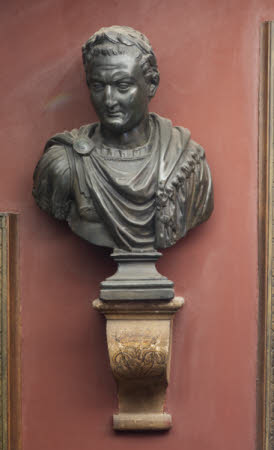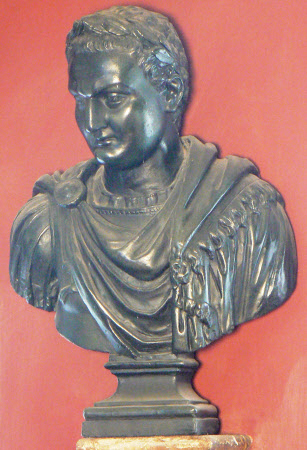Bust of a Roman emperor
workshop of Peter Besnier (fl.1643, d.1687-93)
Category
Art / Sculpture
Date
c. 1660 - 1672
Materials
Plaster of paris, Wood
Place of origin
London
Order this imageCollection
Ham House, Surrey
NT 1139676
Summary
Plaster, painted; portrait bust of a Roman emperor; workshop of Peter Besnier (died 1687/88); c. 1660-72. Wth a laurel wreath in his hair, wearing armour and with his head turned slightly to his right. On a rectangular moulded socle. The plaster is painted black to simulate bronze. One of a group of plaster busts, some of which were installed on the Great Staircase of Ham House in 1671/72. Mounted on a wooden console bracket; painted in gilded lettering with the reversed cypher JEL sumounted by a coronet .
Full description
A plaster portrait bust of a Roman Emperor, his head turned slightly to his right. He has shortish hair and wears a laurel wreath, and he has an intense, slightly puckered expression. The emperor wears all’antica armour, with pauldrons (shoulder pieces) with straps and a cuirass, over which is a cloak covering left shioulder but leaving right shoulder free, and fastened at the right with a circular brooch. On an integral rectangular moulded and indented socle. The plaster is painted black to simulate bronze. The busts on the Great Staircase were in fact originally painted white to resemble statuary marble but were repainted dark in the nineteenth century, to give them the appearance of bronze. The bust is placed on one of three surviving wooden consoles, made in 1673, painted stone colour and with in gold the ‘JEL’ cypher of the Duke and Duchess of Lauderdale. Four plaster busts were installed on the Great Staircase of Ham House in 1671/72, and recorded in the 1677 Ham House inventory as ‘4 heades of plaster’ (Charles Avery, Seventeenth-Century Sculpture at Ham House’ in Christopher Rowell, ed., Ham House. 400 Years of Collecting and Patronage, New Haven/London 2013, pp. 158-77, p. 169). These correspond to the four busts in the broken pedimented overdoors leading off various points of the Great Staircase (NT 1139665; 1139678-80), three of which have identical stepped socles to the three other busts on the Staircase today, where they are set on wooden console brackets made in 1673. The similar socles would suggest that the three busts were made at the same time and presumably as part of the same order as the four recorded in 1677, although Charles Avery suggested that the four busts above the overdoors were likely to have been made earlier. c. 1637-39. Virtually all the sculpture at Ham House, including the busts on the staircase and those in lead set along the garden walls and on the façade of the house, seems to have been made in the workshops of the Besnier family. French in origin, members of the family were appointed as ‘Sculptor in Ordinary’ to, successively, Kings Charles I and II, beginning with Isaac Besnier, who was employed to look after the ‘Moulds, Statues and Modells’ in the royal collections. Isaac probably arrived in London around 1625, perhaps in the retinue of Charles I’s bride Henrietta Maria, and may have left by 1643, when his responsibilities for the sculptures in the royal collections were transferred to his younger brother Peter Besnier (fl. 1643, died 1687/88), to whom is attributed the magnificent bronze bust of Catherine Bruce at Ham House (NT 1139887) as well as the plaster figures of Mars and Minerva in the Great Hall (NT 1139652.1 & 2). After the Restoration Peter Besnier petitioned the new king for restoration of his post and continued to work as a sculptor. His son Thomas (c. 1663-1693) was much praised by George Vertue, whilst another family member, John Besnier, was recorded in 1681 making lead statues for the Duke of Ormonde. Given the close relations between successive monarchs and the owners of Ham, the hypothesis that the Besnier, in the service of the Crown, might have made much of the sculpture at Ham House, is quite plausible. As keepers of the royal sculpture collections, Isaac and Peter Besnier would have enjoyed privileged access to these collections. Jeremy Warren December 2021
Provenance
Probably commissioned by Elizabeth Murray and John Maitland, 1st Duke and Duchess of Lauderdale, and installed on the Great Staircase, c. 1671-73; thence by descent, until acquired in 1948 by HM Government when Sir Lyonel, 4th Bt (1854 – 1952) and Sir Cecil Tollemache, 5th Bt (1886 – 1969) presented Ham House to the National Trust. Entrusted to the care of the Victoria & Albert Museum until 1990, when returned to the care of the National Trust, to which ownership was transferred in 2002.
Makers and roles
workshop of Peter Besnier (fl.1643, d.1687-93), sculptor
References
Avery 2013: Charles Avery, ‘Seventeenth-century Sculpture at Ham House’ in Christopher Rowell, ed., Ham House. 400 Years of History, New Haven/London 2013, pp. 158-77., pp. 169-70.

